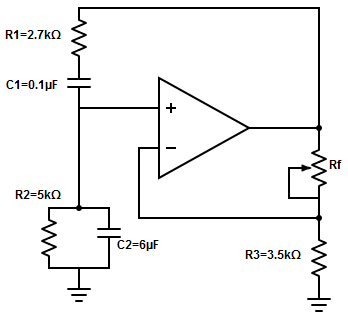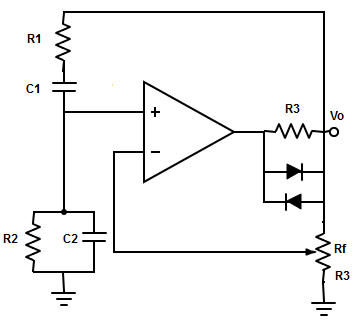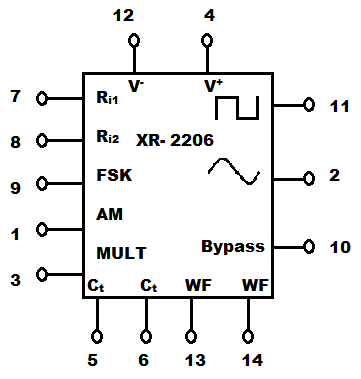21. The value of the feedback resistor in the phase shift oscillator is 180kΩ. Find its input resistance?
A. 52kΩ
B. 151kΩ
C. 209kΩ
D. 6.2kΩ
22. Determine the frequency of oscillation (fo) in phase shift oscillator?
A. fo = √6/ωRC
B. fo = 0.56/ωRC
C. fo = 0.065/ωRC
D. fo = 6/ωRC
23. The condition for zero phase shift in wein bridge oscillator is achieved by
A. Connecting feedback to the non-inverting input terminal of op-amp
B. Balancing the bridge
C. Applying a parallel combination of RC to the feedback network
D. All of the mentioned
24. What is the frequency of oscillation of wein bridge oscillator?
A. fo = 1/(2πRC.
B. fo = 2π/RC
C. fo = RC/2π
D. fo = 2πRC
25. Sustained oscillation in wein bridge oscillator is possible when the value of ß is
A. 3
B. 1/3
C. 1
D. None of the mentioned
26. Determine the value of fo, ß and Rf from the following circuit diagram.

A. fo = 80Hz, ß = 0.162 and Rf = 7kΩ
B. fo = 100Hz, ß = 1.62 and Rf = 7kΩ
C. fo = 60Hz, ß = 0.0162 and Rf = 7kΩ
D. fo = 120Hz, ß = 16.2 and Rf = 7kΩ
27. What is the problem faced by the wein bridge oscillator?
A. Output sinewave gets clipped
B. Output sinewave remains constant without growing
C. Output sinewave keep on decreasing and die out
D. All of the mentioned
28. Find the type of oscillator shown in the diagram

A. Quadrature oscillator
B. Biphasic oscillator
C. RC phase shift oscillator
D. None of the mentioned
29. Calculate the value of capacitance in wein bridge oscillator, such that fo =1755Hz and R=3.3kΩ.
A. 2.7µF
B. 0.91µF
C. 0.03µF
D. 0.05µF
30. Quadrature oscillators have signals with
A. Different frequency
B. Same frequency
C. Opposite frequency
D. Parallel frequency
31. Which of the following component is not used for audio frequency?
A. RC oscillator
B. Wein bridge oscillator
C. LC oscillator
D. None of the mentioned
32. If the resistor and capacitor values are the same in the Quadrature oscillator. Find its frequency of oscillation for R=50kΩ and C=0.01µF.
A. 112Hz
B. 275Hz
C. 159Hz
D. 318Hz
33. What is the possible method used in a Quadrature oscillator to remove distortion from the output waveform?
A. Replace the resistor at the input of a non-inverting type amplifier with a potentiometer
B. Replace the resistor at the output of a non-inverting type amplifier with a potentiometer
C. Replace the resistor at the input of inverting type amplifier with a potentiometer
D. None of the mentioned
34. A Biphasic oscillator produces an output signal that has
A. Cosine wave only
B. Both sine and cosine wave
C. Two identical sine wave
D. Two identical cosine wave
35. If the output of the sinewave oscillator is Vsinωot, then determine the output of the inverter in the Biphasic oscillator.
A. Vsin(ωot+(3π/2))
B. Vsin(ωot+2π)
C. Vsin(ωot+π)
D. Vsin(ωot+(π/2))
36. A function generator can produce
A. Many identical waves
B. Square and sine waves only
C. Different types of waves simultaneously
D. None of the mentioned
Answer: Oscillator circuits generate only one type of waveform like square, triangular, or sine wave separately, whereas a function generator can produce all three types of waves simultaneously. [/bg_collapse]
37. Which of the following have distorted sinewave?
A. Function generator
B. Biphasic oscillator
C. RC phase shift oscillator
D. Wein bridge oscillator
38. Usually circuit producing sine waves are called as
A. Oscillators
B. Generators
C. Multivibrators
D. All of the mentioned
39. An IC function generator can allow the signals for
A. Amplitude Modulation (AM)
B. Frequency Modulation (FM)
C. Frequency Shift Keying (FSK)
D. All of the mentioned
40. The current in the XR-2206 Function generator is determined by
A. External resistors
B. External capacitors
C. External capacitors or external resistors
D. Both external capacitor and external resistor
41. What will be the output, if a 180Ω resistor that was connected between the 13th and 14th pin terminal is removed.

A. A triangular wave
B. A sine wave
C. A square wave
D. A rectangular wave
42. Find the difference of potential that can be applied to the XR-2206 function generator.
A. 26v
B. 5v
C. 19v
D. 30v
43. The value of current and frequency of the output waveform is 5A and 13.33kHz. Find the capacitance value in the function generator?
A. 250µF
B. 120µF
C. 850µF
D. 370µF
44. How many sets of pins are required to control the frequency in the XR-2206 function generator?
A. Two
B. Three
C. Four
D. None of the mentioned
